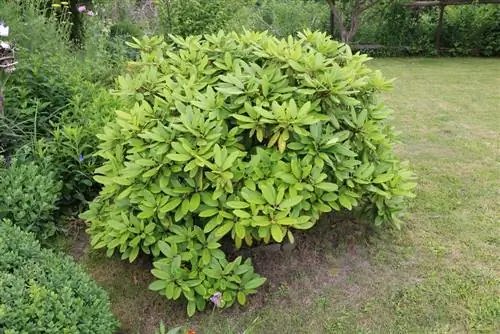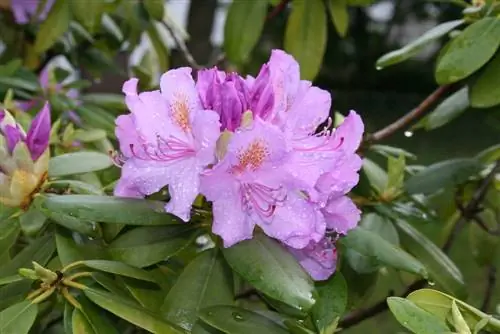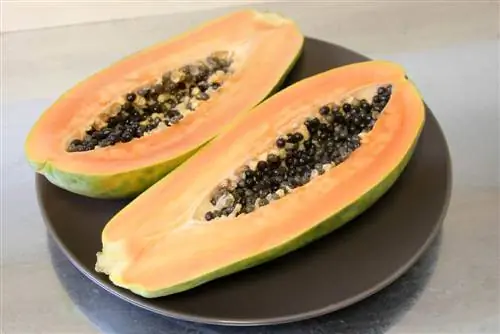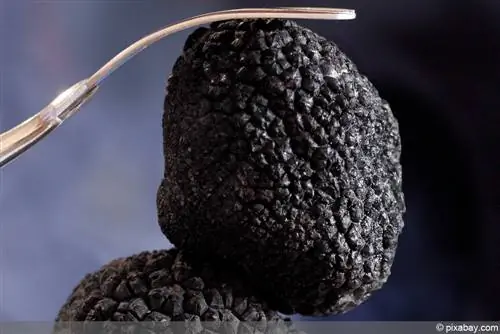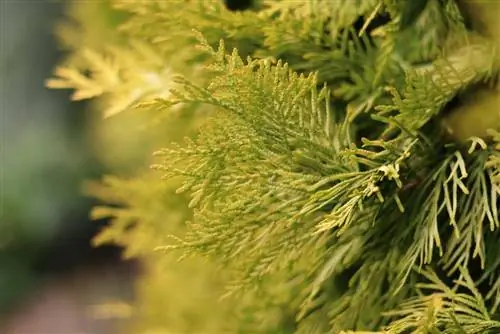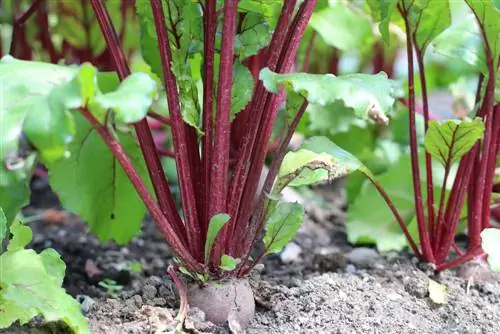- Author admin [email protected].
- Public 2023-12-17 03:39.
- Last modified 2025-01-24 12:45.
The rhododendron belongs to the heather family and is a beautiful addition to any garden. Due to the large number of species with different characteristics, growth and the height to be achieved also vary extremely. Depending on the species, the plants grow from dwarf-like shrubs to tree-shaped trees. Both the site conditions and the care have a major influence on the respective growth.
Growth
In general, rhododendrons grow very slowly; the plants only reach their final height and width after many years. Through breeding, large and faster-growing species are now available, as well as smaller, dwarf varieties. Most of the flowering shrubs are evergreen, although deciduous varieties are rarer. Anyone who chooses rhododendrons to create a hedge or as an ornamental shrub will enjoy the magnificent flowers for a long time. Due to the dark green and well-growing foliage, the plants grow over time into a dense hedge, which serves as a privacy screen for the garden. Before selecting the variety, you should definitely consider the conditions at the desired location, as these factors have an extreme influence on growth. If the bushes are given the right place, the care measures are also simplified.
- Mostly robust, winter-resistant and flowering trees
- Growth heights vary depending on the variety
- Plants have compact growth
- Leaves and flowers are just as different
- Shrubs grow quite slowly
- Growth becomes more magnificent from year to year
- Woods can get extremely old
- The right location conditions are extremely important
- Proper care has a positive effect on growth
- Flowers enchant with a varied color palette
- Color spectrum includes blue-violet, yellow, pink, red to white
Ideal location conditions

The rhododendron is a sensitive plant and has certain demands on its location. If these conditions are not met, this will have a detrimental effect on growth. Young plants in particular are very sensitive to strong sunlight, but older plants become significantly more resistant over time. When the rhododendron has grown large, it needs a lot more light. Locations where the incidence of light increases as the plant grows are therefore ideal. If the rhododendron has become too large for its current location, it is recommended to transplant it instead of cutting it back. Diseases can also lead to stunted growth; although they are rare, they are promoted by unfavorable location conditions and care errors. Due to the fine roots, heavy clay soils are unsuitable for the plants.
- Grows best in partial shade
- Mild temperatures are ideal
- Location should be protected from the wind
- Full sun and strong heat initially inhibit growth
- Prefers acidic soils, with pH values of 4.0 to 5.5
- Does not tolerate calcareous soil qualities
- Soil must be permeable to water and air
- Loosen the soil well before planting
- Prevent waterlogging at all costs
Tip:
If the soil quality at the desired location is not right, then the soil should be additionally enriched. A mixture of humus with special rhododendron soil is ideal.
Cutting
If the rhododendrons are still young, it makes sense to give them a shape-giving pruning. This promotes compact growth, especially if the space on the sides is limited. Very densely growing bushes should be thinned out so that light can continue to fall into the crowns. Vital and he althy plants sprout again abundantly after the cutting measures, and the abundance of flowers also increases. If the plants are cultivated in a bucket, they must be repotted as they grow taller and wider. When repotting, it is advisable to shorten the root system slightly. This activates the formation of new roots and stimulates general growth.
- Pluck out wilted and dried plant parts regularly
- Cut off diseased and frozen shoots
- Break off spent umbels
- Cut back bald and poorly developed shoots
- Scarcely growing specimens need radical rejuvenation pruning
- The right time for cutting is after the flowering period
- Plant then forms buds again until autumn
- Pruning stimulates new growth
- Then the growth becomes bushier and more branched
Proper care
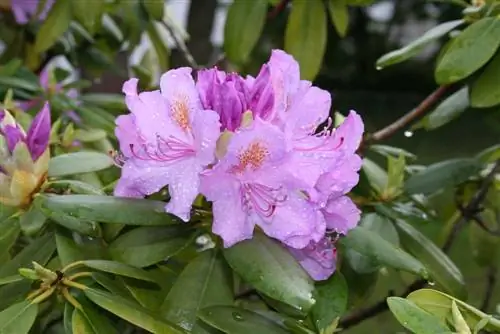
Regular watering and sustainable fertilization are extremely important for fast and dense growth. Newly planted or freshly cut specimens in particular need a lot of water; they also need to be watered in rainy weather. On the other hand, older and well-rooted specimens can regulate their water balance independently when normal weather conditions prevail. Although the plants need sufficient water, if the roots are permanently too wet, the plants will die quickly. The root system of rhododendrons is finely fibrous and is located close to the surface. Therefore, the soil around the tree should not be chopped through, as this can cause serious injury to the roots. In addition, other shallow-rooted plants should be avoided as plant neighbors of rhododendrons, otherwise the resulting root competition will negatively affect growth.
- Always keep the soil slightly moist, but never too wet
- After rooting, weekly watering sessions are sufficient
- Use only low-lime water
- Collected rainwater is ideal
- As an alternative, stale tap water is possible
- It is best to fertilize from May to September
- Ecological fertilizers with magnesium and iron are ideal
- This includes horn shavings, cattle dung and blue grain
- Rhododendron fertilizer offers the perfect mixing ratio
- Special fertilizers lower the pH value
- Protect from cold winds in the winter months
Note:
If the tap water in the region is extremely hard, it can be softened with peat. Simply hang a bag with some peat in the watering can for a day.
Species
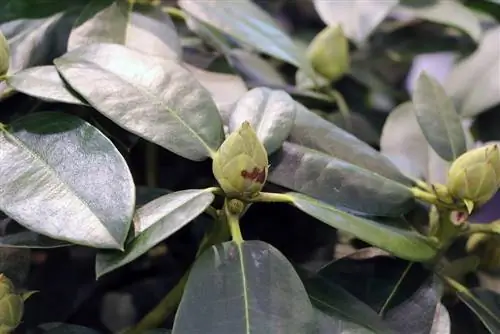
Every spring, the local gardens and parks shine in a bright sea of color. The reason for this is the impressive rhododendrons, which have become very popular in this country. There are now more than 1,000 known species, most of which are found in the northern hemisphere. Rhododendrons work very well as hedges and as plantings between larger neighboring trees.
- Creeping species only grow up to 30 cm high
- Suitable for rock gardens, pots and as houseplants
- Semi-tall species reach heights of between 1 and 1.5 m
- Ideal for flower borders and as an ornamental shrub in the front garden
- Tall species grow upwards of over 2 m
- Can be combined in shrub borders
- Ornament as a solitary plant in individual stands
Barbarella
- Modern breeding with flowers in orange, yellow, red and pink
- small-flowered, but extremely flowery
- Flowering time in May
- Grows extremely slowly
- Becomes about 35 cm high after ten years
- Reaches width of 60 cm
Catawbiense Grandiflorum
- Wintergreen variety with purple flowers
- Blooms from May to June
- Extremely frost hardy and robust
- Maximum growth height is 2 to 3 m
- Maximum width is 2 m
- Grows 20 to 30 cm per year
Cunninghams White
- Evergreen variety with large and white flowers
- Blooms from May to June
- Very robust and frost-resistant
- Maximum height is 2 m
- Maximum width is also 2 m
- Grows up to 20 cm per year
Germania
- Wintergreen variety with dark pink flowers
- Blooms from May to June, very decorative
- Extremely hardy and easy to care for
- Maximum growth height is 2 m
- Maximum width is also 2 m
- Grows about 10 cm per year
Gold Prince
- Decorative Yakushimanum Hybrids
- Forms intense golden yellow flowers
- Slightly ruffled petals with dark mottled spots
- Blooms from mid-May
- Becomes about 70 cm high after ten years
- Reaches width of 90 cm
- Needs extra protection in harsh winters
Gomer Waterer
- Evergreen variety with light pink to white flowers
- Blooms from May to June
- Frost-resistant and easy to care for
- Maximum growth height is 2 m
- Maximum width is also 2 m
- Grows about 10 cm per year
Madame Masson
- Evergreen variety with white flowers
- The yellow flower center is particularly decorative
- Blooms from May to June
- Very frost hardy and easy to care for
- Maximum growth height is 2 to 3 m
- Maximum width is 2 m
- Grows 20 cm per year
Marcel Menard
- One of the oldest and most popular varieties
- Wintergreen with dark purple flowers
- Flower center is orange-brown
- Blooms from May to June
- Very frost hardy and easy to care for
- Maximum growth height is 2 m
- Maximum width is also 2 m
- Grows 20 cm per year
Nova Zembla
- Evergreen variety with red flowers
- Blooms from April to May
- Very frost hardy and easy to care for
- Maximum growth height is 2 m
- Maximum width is also 2 m
- Grows 20 cm per year
Red Jack
- Evergreen variety with red flowers
- Blooms from April to May
- Only conditionally hardy, can tolerate down to -10 °C
- Does not like cold and windy locations
- Maximum growth height is 2 m
- Maximum width is also 2 m
- Grows about 20 cm per year
Roseum Elegans
- Wintergreen variety with purple to pink flowers
- Blooms from May to June
- Very hardy and decorative
- Maximum growth height is 2 to 3 m
- Maximum width is 2 m
- Grows 20 to 25 cm per year

